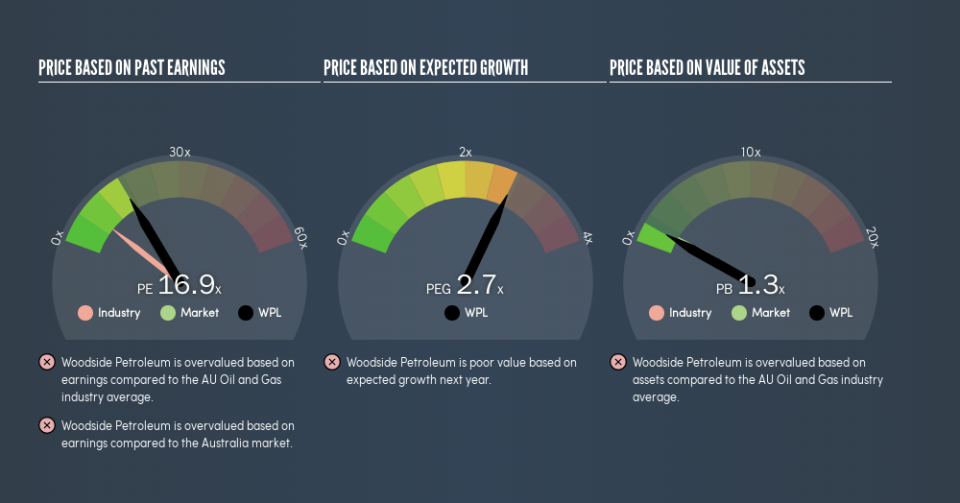Should You Be Tempted To Sell Woodside Petroleum Ltd (ASX:WPL) Because Of Its P/E Ratio?

Want to participate in a short research study? Help shape the future of investing tools and you could win a $250 gift card!
Today, we'll introduce the concept of the P/E ratio for those who are learning about investing. To keep it practical, we'll show how Woodside Petroleum Ltd's (ASX:WPL) P/E ratio could help you assess the value on offer. What is Woodside Petroleum's P/E ratio? Well, based on the last twelve months it is 16.86. That is equivalent to an earnings yield of about 5.9%.
Check out our latest analysis for Woodside Petroleum
How Do You Calculate Woodside Petroleum's P/E Ratio?
The formula for P/E is:
Price to Earnings Ratio = Share Price (in reporting currency) ÷ Earnings per Share (EPS)
Or for Woodside Petroleum:
P/E of 16.86 = $24.96 (Note: this is the share price in the reporting currency, namely, USD ) ÷ $1.48 (Based on the year to December 2018.)
Is A High P/E Ratio Good?
The higher the P/E ratio, the higher the price tag of a business, relative to its trailing earnings. All else being equal, it's better to pay a low price -- but as Warren Buffett said, 'It's far better to buy a wonderful company at a fair price than a fair company at a wonderful price.'
How Growth Rates Impact P/E Ratios
Probably the most important factor in determining what P/E a company trades on is the earnings growth. Earnings growth means that in the future the 'E' will be higher. That means unless the share price increases, the P/E will reduce in a few years. So while a stock may look expensive based on past earnings, it could be cheap based on future earnings.
It's great to see that Woodside Petroleum grew EPS by 20% in the last year. And it has improved its earnings per share by 261% per year over the last three years. This could arguably justify a relatively high P/E ratio. Unfortunately, earnings per share are down 7.0% a year, over 5 years.
How Does Woodside Petroleum's P/E Ratio Compare To Its Peers?
One good way to get a quick read on what market participants expect of a company is to look at its P/E ratio. As you can see below, Woodside Petroleum has a higher P/E than the average company (7.9) in the oil and gas industry.
That means that the market expects Woodside Petroleum will outperform other companies in its industry. The market is optimistic about the future, but that doesn't guarantee future growth. So further research is always essential. I often monitor director buying and selling.
Don't Forget: The P/E Does Not Account For Debt or Bank Deposits
Don't forget that the P/E ratio considers market capitalization. Thus, the metric does not reflect cash or debt held by the company. In theory, a company can lower its future P/E ratio by using cash or debt to invest in growth.
Such spending might be good or bad, overall, but the key point here is that you need to look at debt to understand the P/E ratio in context.
So What Does Woodside Petroleum's Balance Sheet Tell Us?
Woodside Petroleum has net debt worth just 9.9% of its market capitalization. It would probably trade on a higher P/E ratio if it had a lot of cash, but I doubt it is having a big impact.
The Verdict On Woodside Petroleum's P/E Ratio
Woodside Petroleum trades on a P/E ratio of 16.9, which is fairly close to the AU market average of 16.2. With only modest debt levels, and strong earnings growth, the market seems to doubt that the growth can be maintained. Since analysts are predicting growth will continue, one might expect to see a higher P/E so it may be worth looking closer.
Investors should be looking to buy stocks that the market is wrong about. People often underestimate remarkable growth -- so investors can make money when fast growth is not fully appreciated. So this free visualization of the analyst consensus on future earnings could help you make the right decision about whether to buy, sell, or hold.
But note: Woodside Petroleum may not be the best stock to buy. So take a peek at this free list of interesting companies with strong recent earnings growth (and a P/E ratio below 20).
We aim to bring you long-term focused research analysis driven by fundamental data. Note that our analysis may not factor in the latest price-sensitive company announcements or qualitative material.
If you spot an error that warrants correction, please contact the editor at editorial-team@simplywallst.com. This article by Simply Wall St is general in nature. It does not constitute a recommendation to buy or sell any stock, and does not take account of your objectives, or your financial situation. Simply Wall St has no position in the stocks mentioned. Thank you for reading.

